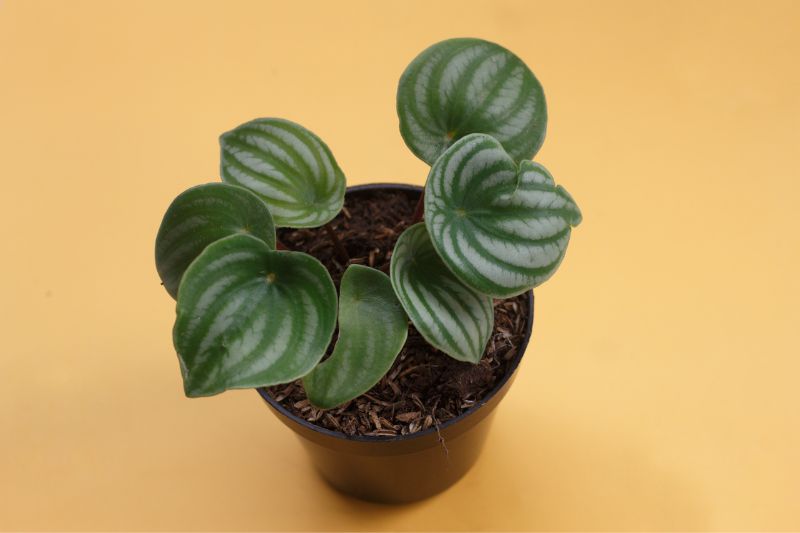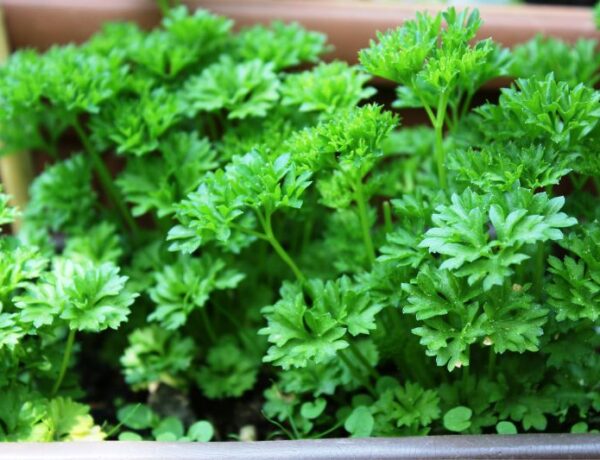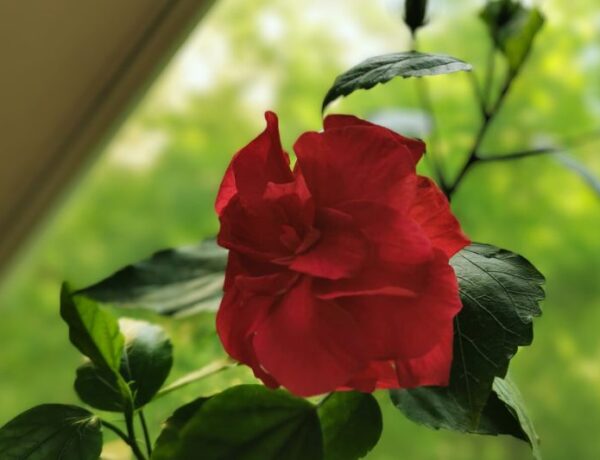Watermelon Peperomia Plant Care Snapshot
Peperomia argyreia’s striking, striped leaves are low-maintenance and pet-safe—here’s the quick guide to keeping yours healthy and happy.
Watering
Typically 7–14 days
Light
Bright, indirect light
Growth Rate
Slow to moderate
Care Level
Beginner-friendly
Pet-Friendly
Non-toxic to cats and dogs
Leaf Patterns & Growth Habit
Peperomia argyreia is prized for its thick, glossy, ovate leaves striped in silvery-white over deep green—each leaf a perfect “watermelon rind.”
Unlike many peperomias, it maintains a neat, upright rosette without vigorous trailing, making it an ideal tabletop or shelf specimen.
Key Points:
- Distinctive Foliage: Broad leaves with alternating pale-silver and dark-green bands.
- Compact Form: Grows in a tight clump up to 12 cm tall and wide.
- Optional Blooms: Tiny, club-shaped flowers appear occasionally; pinch them off to keep energy focused on foliage.

Watermelon Peperomia Plant Care & Growing Requirements
Start here for all the foundational steps to keep your Watermelon Peperomia healthy—dive into watering, light, soil, temperature and humidity.
Watering Schedule
The Watermelon Peperomia prefers its soil to dry out slightly between waterings. Overwatering leads to root rot, while letting it go bone-dry can stress the plant.
Quick Tips:
- Don’t let the pot sit in water—remove it after 20 min.
- Yellowing leaves = overwatering; skip the next cycle.
- If soil pulls away from the pot edge, it’s time to water.
Light & Placement
Bright, indirect light is ideal—too little dulls the stripe pattern, too much scorches the leaves.
Quick Tips:
- Turn the plant ¼-turn each week so all sides receive even light.
- Leggy stems? Move a little closer to the light source.
- Add a 6 W LED grow lamp if natural light is under 200 lux.
- Watch for pale patches—sign of unfiltered sunburn.
Soil & Repotting
A fast-draining, airy mix prevents waterlogging and mimics the plant’s epiphytic roots.
Quick Tips:
- Always use a pot with drainage holes; terra-cotta pots help wick away excess moisture.
- Repot very 2–3 years in spring—choose only one size larger to avoid excess soil.
Humidity & Temperature
Watermelon Peperomia enjoys moderate humidity and average indoor temperatures.
Quick Tips:
- 40–60 % relative humidity; 18–26 °C (65–80 °F) during the day.
- Don’t let temps drop below 12–15 °C (55–60 °F).
- Keep clear of air-con vents, heaters, or drafty windows.
- Brown leaf tips? Likely low humidity—mist lightly once a week.
Propagation
Propagate Watermelon Peperomia easily by leaf cuttings or division—no special tools needed.
Leaf cutting method
- Select a healthy leaf with 2–3 cm of stem.
- Insert the stem into moist propagation mix (peat + perlite).
- Cover with clear plastic or a dome to retain humidity.
- Place in bright, indirect light; roots appear in 3–6 weeks.
Division method
- Gently remove the plant from its pot in spring.
- Find natural clumps and tease apart, ensuring each section has roots.
- Pot into fresh, well-draining mix and water lightly.
Fertilizer
Regular feeding during the growing season keeps leaves vibrant without overdoing it.
Quick Tips:
- Use a balanced, water-soluble houseplant fertilizer (e.g. 10-10-10)
- At half the manufacturer’s recommended strength
- Every 4–6 weeks from spring through summer
Flowering
Peperomia argyreia occasionally produces inconspicuous flower spikes—but flowers are purely ornamental and can sap energy from foliage.
Quick Notes:
- When: Late spring to early summer, under optimal light
- What to expect: Thin, greenish-white “pins” rising above the leaves
- Managing blooms: Snip off the flower stalk at the base once you’ve enjoyed it
Essentials & Stylish Accents
Give your Watermelon Peperomia the perfect foundation—from airy soil and a matching planter to precise care tools and on-demand nutrition—so its signature striped leaves stay lush and vibrant.

FoxFarm Ocean Forest Potting Soil
A premium, well-draining mix of earthworm castings, bat guano, fish & crab meal and sphagnum peat moss—ideal for feeding and aerating the shallow roots of Peperomia argyreia.
Shop on Amazon →
Gepege Rainbow Pearl Glaze Planter Trio
Three stoneware pots (6″, 5″, 4″) in a soft pearl finish, each with a drainage hole and saucer—keeps your plant stylishly contained and root-healthy.
Shop on Amazon →
2-in-1 Soil Moisture + Light Meter
A single probe that checks soil dryness and measures light levels, so you’ll never overwater or leave your Peperomia in too-dim conditions.
Shop on Amazon →
Miracle-Gro Indoor Plant Food
Convenient pump-bottle concentrate (1–2 pumps per watering) delivers balanced 1-1-1 nutrients exactly when your plant needs them—no mess, no measuring.
Shop on Amazon →As an Amazon Associate, I earn from qualifying purchases—thanks for supporting our plant guides!
Foliage & Close-Up Gallery



Let the top 1–2 inches of soil dry out between waterings—usually every 7–14 days. Adjust based on light levels and temperature: more light or heat means slightly more frequent waterings.
Bright, indirect light is best. Too little light will dull its silvery stripes and encourage legginess; direct afternoon sun can scorch the foliage.
Leaf cutting: Snip a healthy leaf with a short petiole, insert it into moist mix, cover to maintain humidity, and root in 3–6 weeks.
Division: In spring, gently separate root clumps and pot each section into fresh mix.
Drooping often means over- or under-watering—check soil moisture and adjust accordingly.
Yellowing usually indicates too much moisture; allow the soil to dry more between waterings.
Pinch back any leggy stems to encourage a fuller rosette, and remove yellow or damaged leaves to keep your plant looking its freshest.
Yes—Peperomia argyreia is non-toxic to cats and dogs, making it an excellent choice for homes with pets.
Mealybugs and spider mites can appear in dry conditions. At the first sign, wipe leaves with a gentle insecticidal soap or neem-oil spray to keep infestations at bay.
Conclusion
The Watermelon Peperomia is a resilient and attractive indoor plant. It’s surprisingly sturdy despite its delicate appearance. With proper care and attention to its moderate watering and lighting needs, it can be a vibrant addition to any indoor gardening collection.
Also, if you’re interested in exploring more plants with unique leaf patterns, be sure to visit our guides on houseplants with striped leaves and those with dotted foliage. They’re full of inspiring options to add diversity to your collection!






No Comments